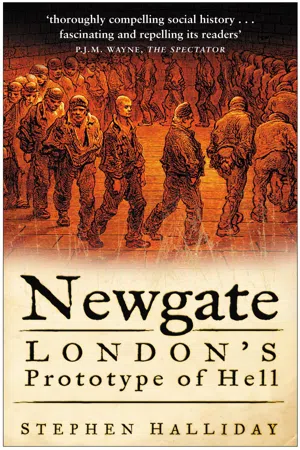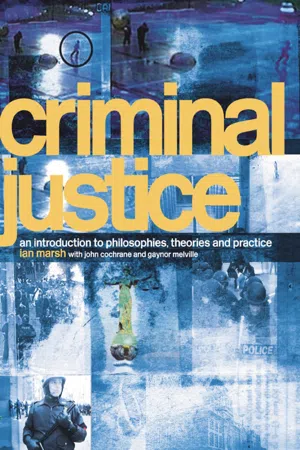History
Bloody Code
The "Bloody Code" refers to the harsh and punitive criminal laws in England during the 18th and early 19th centuries. It included a wide range of offenses that were punishable by death or transportation, and the penalties were often disproportionately severe. The term reflects the brutal and unforgiving nature of the legal system during this period.
Written by Perlego with AI-assistance
Related key terms
4 Key excerpts on "Bloody Code"
- eBook - ePub
Newgate
London's Prototype of Hell
- Stephen Halliday(Author)
- 2007(Publication Date)
- The History Press(Publisher)
THREE The Bloody Code: Punishment in Hanoverian England The Bloody Code was monstrous and ineffectual. Its vice lay in the enormous disproportion it maintained between offences and penalties. It gave the impression of a world in which ‘great thieves hang little ones’. It was not justice that was administered; it was a war that was waged between two classes of the community. (The Times, editorial, 25 July 1872) Instead of making the gallows an object of terror, our executions contribute to make it an object of contempt in the eye of the malefactor; and we sacrifice the lives of men, not for the reformation but the diversion of the populace. (Henry Fielding, magistrate at Bow Street) THE PENAL CODE In 1582 William Lambard of Lincoln’s Inn applauded the fact that the English penal code no longer included ‘pulling out the tongue for false rumours, cutting off the nose for adultery, taking away the privy parts for counterfeiting of money’ or certain other punishments associated with the Medieval period. That is not to say that the remaining penalties were altogether humane. Lambard divided them into three categories – infamous, pecuniary and corporal. 1 Infamous punishments were reserved for crimes such as treason and involved such hideous processes as hanging, drawing and quartering. Pecuniary penalties involved fines for such offences as swearing, playing a musical instrument on the Sabbath or failing to attend church. They were mostly imposed by Justices of the Peace and constituted an important source of revenue for the clerks who advised the Justices. The third category, corporal punishments, Lambard divided into ‘either Capital or not Capital. Capital (or deadly) punishment is done sundry ways, as by hanging, burning, boiling or pressing - eBook - ePub
- Barry Godfrey, Graeme Dunstall(Authors)
- 2013(Publication Date)
- Willan(Publisher)
an astute ruling class who manipulated it to their advantage , and a people schooled in the lessons of Justice, Terror and Mercy. (my italics)Here, the ‘Bloody Code’ was not some kind of pre-Enlightenment accident of history which the ensuing rationality and humanitarianism of the post-Enlightenment period resolved; instead, it was an integral feature of the way in which the ruling class had exercised their power at that time. And that it did change was due to class struggle and resistance on the one hand, and the need for penal strategies more suited to the labour demands of industrial capitalism on the other (although these interpretations of eighteenth- and early nineteenth-century history have since been disputed by King (1984) and Beattie (1986)).By this juncture, the work of Rusche and Kirchheimer had been resurrected and was influential on a number of historical analyses of penal trends and developments that drew on Marxist concepts and ideas (see Melossi and Pavarini, 1981), as well as being at last celebrated and recognised in its own right (see Melossi, 1978, 1980). Indeed, the historical analysis of punishment began to have an increasingly important place within the field of critical criminology: the purpose being to show the underlying material conditions that were responsible for penal change. Scull (1978), for example, argued that the shift towards decarceration then under way in relation to penal and mental institutions was more to do with the fiscal crisis of welfare capitalism than the good intentions of social reformers. He set out his argument by means of an historical analysis of the relationship between the development of modern capitalist society and its ‘apparatuses’ of social control, and then linked contemporary changes to the harnessing of drug technology to the economic imperatives of fiscal restraint by the state.5 - eBook - ePub
Criminal Justice
An Introduction to Philosophies, Theories and Practice
- Ian Marsh, John Cochrane, Gaynor Melville(Authors)
- 2004(Publication Date)
- Routledge(Publisher)
Albion’s Fatal Tree: Crime and Society in the 18th Century, Harmondsworth: Penguin. A classic historical analysis of the use of the criminal law as an ideological weapon. It focuses on the manipulation of the ‘Bloody Code’ by ‘an astute ruling class in their own interests’. Hay’s essay ‘Property, Authority and the Criminal Law’ is particularly recommended as a study of eighteenth-century capital punishment.Morris, N. and Rothman, D. J. (1998) The Oxford History of the Prison: The Practice of Punishment in Western Society, Oxford: Oxford University Press. This provides a comprehensive coverage of the history of incarceration from ancient times to the modern day. Examples are drawn from Britain, continental Europe and the United States.Sharpe, J. A. (1999) Crime in Early Modern England, 1550–1750, 2nd edn, Harlow: Longman. An excellent, wide-ranging analysis of crime, criminality and punishment in the early modern period. Especially useful are chapters 3 and 4 on measuring and controlling crime. Chapter 5 is a valuable study of offenders which includes a useful section on gender. Other areas covered include popular attitudes to criminality and elite perceptions of crime and threat.Passage contains an image
4 Victimology
Introduction
It goes without saying that any criminal justice system will be preoccupied with the behaviour, the punishment and the rehabilitation of the criminal. The behaviour of the criminal has been the particular focus of criminology, although work in this area overlaps with a number of academic disciplines, including sociology and psychology. As regards the punishment of offenders, the different aims of and justifications for punishment, whether they be essentially retributive or reformative, have sparked continued philosophical debate. However, this academic obsession with the criminal has been at the expense of detailed consideration of the victim. Indeed, the victim often seems to be added to criminological theorising and debate merely out of politeness or political correctness. The consequences of this omission are important. The lack of academic interest has left the victim in the dark – a situation that has led to a good deal of public policy making not being informed by the needs, wants and status of the victim within the criminal justice system. - eBook - ePub
The Birth of Industrial Britain
1750-1850
- Kenneth Morgan(Author)
- 2013(Publication Date)
- Routledge(Publisher)
‘Bloody Code’. Many such crimes already existed under common law, but they were now explicitly added to the statute books. Over 150 such offences were made capital crimes in that period, including over 50 at one fell swoop with the Waltham Black Act (1723), ostensibly aimed at poaching from the royal forests. It was not until the 1820s that many capital offences were repealed by various statutes dealing with obsolete laws, something that was influenced by the reprieve of so many capital offenders. The Criminal Justice Act of 1827 abolished ‘benefit of clergy’, a hangover from the ecclesiastical court of the sixteenth century that was extended to people who could demonstrate basic literacy. In so doing, the statute restricted the death penalty to felonies from which benefit of clergy had previously been excluded. The Whig governments of the 1830s continued to reduce the number of capital crimes, taking account of the findings of a Royal Commission on the Criminal Law. By 1841 this resulted in the death penalty being used almost solely for those convicted of murder.Bloody Code: A term applied by historians to the series of criminal statutes enacted by eighteenth-century British Parliaments, many of which prescribed the death penalty. There were over 200 capital statutes by the end of the eighteenth century.There was a general expansion in the inclusion of non-capital crimes on the statute book in early industrial Britain, especially those dealing with summary jurisdiction. Most non-capital crimes consisted of grand larceny (defined as theft of goods worth more than 39 shillings) and petty larceny (stealing goods worth less than that amount). The distinction between the two types of larceny was abolished in 1827 and replaced with a new offence called simple larceny. Larcenists could be pickpockets, livestock stealers, game poachers, thieves taking clothes, food, coal and industrial goods, and perpetrators of other crimes against property. A summary of one trial involving a pickpocket at the Old Bailey illustrates how courts handled such cases (Doc. 29, p. 148).Along with the changes in statute law concerning crimes came new ideas about punishment and increased means of law enforcement. By 1850 there were more laws against property crimes, a wider range of criminal punishments, and more direct and effective policing of communities compared with a century before. This chapter considers the changes occurring in crime, justice and punishment in early industrial Britain.
Learn about this page
Index pages curate the most relevant extracts from our library of academic textbooks. They’ve been created using an in-house natural language model (NLM), each adding context and meaning to key research topics.



